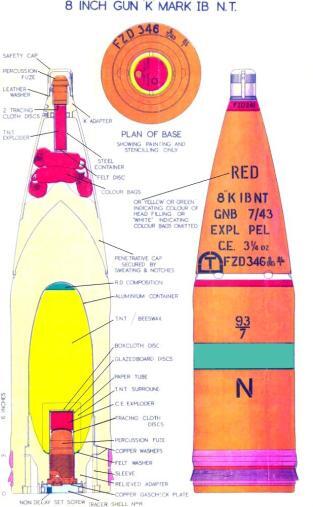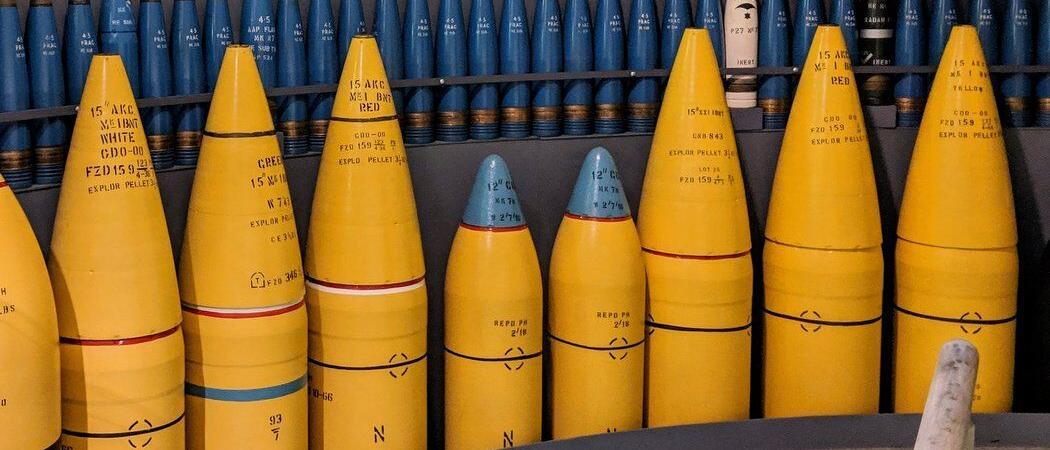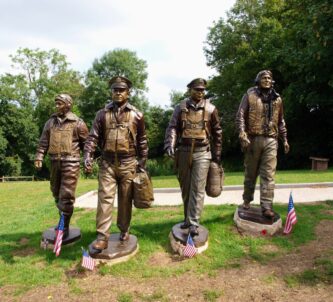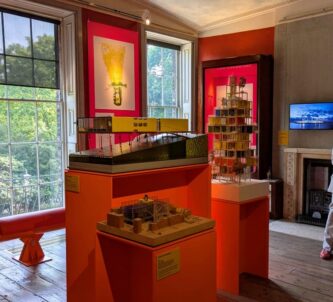The answer is NO, but what’s interesting is that if she had made her ill-fated breakout into the Atlantic a year later, she might have been. By then, if the same ships had intercepted her they would have been carrying red (HMS Rodney) and yellow (HMS King George V) dyed shells.
The French had developed naval shells with dyes after the First World War. The idea was that in a multi-ship engagement their ships could each identify their own fall of shot from the coloured splashes.
In 1939 their ‘Dispositif K’ dyed shell technology was passed to the British and ‘K shells’ were introduced to the Royal Navy from late 1942.¹
Meanwhile the Imperial Japanese Navy (IJN) had also introduced dyed shells and the US Navy started developing their own dyed shells.

(Image: War Office, public domain)
It appears dyed shells were mostly large calibre and generally used only by capital ships. They wouldn’t be used at night, obviously, and were only needed when more than one capital ship was firing. Later, radar tracking made dyed shell technology obsolete.
So, where and when were they actually used?
The best known event was the engagement off Samar during the Battle of Leyte Gulf in Oct 44, when the IJN ‘Centre Force’ comprising 4 x battleships (Yamato, Haruna, Nagato and Kongō), 6 x heavy cruisers, 2 x light cruisers and 11 x destroyers, caught the US 7th Fleet’s three escort carrier groups entirely by surprise and unprotected. In a heroic YOLO* charge, the destroyer USS Johnston took on the heavy cruisers with her torpedoes & guns and was bracketed by multi-coloured fire from them and the nearby battleships. The same happened to the other US destroyers who followed her example.
Returning to the Bismarck, there is some suggestion¹ Bismarck’s victim, HMS Hood, saw dyed shells being used when she attacked the Vichy French Navy at Mers-el-Kébir (Oran) in July 1940. The 7.6″ guns of the French battery on the heights at Djebel Santon started shelling Hood’s destroyer escorts with coloured shells.
Since nearly all the old photos & film footage from WW2 are in B&W, there is no photographic evidence of dyed shells in use, but there are reports of ships and crew under fire, being covered in red & green dye from near misses.
You can see the K shells in the feature image at the National Museum of the Royal Navy’s ‘Explosion’ museum of naval firepower at Priddy’s Hard, Gosport.
If you have any extra intel on this subject, please add it in the comments. In particular, two unanswered questions: Did the Kriegsmarine, or the Regia Marina, ever use coloured shells?
* Dyed shell allocations (as at, or before, the end of the war in 1946)
| Royal Navy | ||
|---|---|---|
| HMS King George V | 14″ | Yellow |
| HMS Duke of York | 14″ | Green |
| HMS Anson | 14″ | White (IE no dye) |
| HMS Howe | 14″ | Red |
| HMS Queen Elizabeth | 15″ | Red |
| HMS Valiant | 15″ | Green |
| HMS Vanguard | 15″ | Yellow |
| HMS Renown | 15″ | No dye |
| HMS Rodney | 16″ | Red |
| HMS Nelson | 16″ | No dye |
| Imperial Japanese Navy | ||
| Yamoto | 18″ | Red |
| Hiei | 14″ | Black |
| Kirishima | 14″ | Blue |
| Haruna | 14″ | Green |
| Kongō | 14″ | Yellow |
| Nagato | 16″ | Orange |
| US Navy | ||
| USS New Mexico (BB-40) | 14″ | Green |
| USS Mississippi (BB-41) | 14″ | Orange |
| USS Idaho (BB-42) | 14″ | Blue |
| USS Tennessee (BB-43) | 14″ | No Dye |
| USS California (BB-44) | 14″ | No Dye |
| USS Nevada (BB-36) | 14″ | Orange |
| USS Pennsylvania (BB-38) | 14″ | Red |
| USS Colorado (BB-45) | 16″ | Orange |
| USS Maryland (BB-46) | 16″ | Blue |
| USS West Virginia (BB-48) | 16″ | No dye |
| USS North Carolina (BB-52) | 16″ | Green |
| USS Washington (BB-47) | 16″ | Orange |
| USS South Dakota (BB-59) | 16″ | Blue |
| USS Iowa (BB-61) | 16″ | Orange |
| USS New Jersey (BB-62) | 16″ | Blue |
| USS Missouri (BB-63) | 16″ | Red |
| USS Wisconsin (BB-64) | 16″ | Green |
| French Navy | ||
| Richelieu | 15″ (380mm) | Yellow |
| Jean Bart | 15″ (380mm) | Orange |
** YOLO – You Only Live Once
¹ https://forum.axishistory.com/viewtopic.php?t=162349







